An official website of the United States government
 United States Department of Labor
United States Department of Labor
Operate Magnetic Resonance Imaging (MRI) scanners. Monitor patient safety and comfort, and view images of area being scanned to ensure quality of pictures. May administer gadolinium contrast dosage intravenously. May interview patient, explain MRI procedures, and position patient on examining table. May enter into the computer data such as patient history, anatomical area to be scanned, orientation specified, and position of entry.
Employment estimate and mean wage estimates for Magnetic Resonance Imaging Technologists:
| Employment (1) | Employment RSE (3) |
Mean hourly wage |
Mean annual wage (2) |
Wage RSE (3) |
|---|---|---|---|---|
| 39,270 | 2.2 % | $ 36.52 | $ 75,960 | 0.5 % |
Percentile wage estimates for Magnetic Resonance Imaging Technologists:
| Percentile | 10% | 25% | 50% (Median) |
75% | 90% |
|---|---|---|---|---|---|
| Hourly Wage | $ 25.43 | $ 29.87 | $ 35.91 | $ 42.49 | $ 50.10 |
| Annual Wage (2) | $ 52,880 | $ 62,140 | $ 74,690 | $ 88,370 | $ 104,210 |
Industries with the highest published employment and wages for Magnetic Resonance Imaging Technologists are provided. For a list of all industries with employment in Magnetic Resonance Imaging Technologists, see the Create Customized Tables function.
Industries with the highest levels of employment in Magnetic Resonance Imaging Technologists:
| Industry | Employment (1) | Percent of industry employment | Hourly mean wage | Annual mean wage (2) |
|---|---|---|---|---|
| General Medical and Surgical Hospitals | 23,230 | 0.42 | $ 35.95 | $ 74,780 |
| Medical and Diagnostic Laboratories | 7,410 | 2.72 | $ 37.20 | $ 77,370 |
| Offices of Physicians | 5,210 | 0.20 | $ 35.48 | $ 73,810 |
| Outpatient Care Centers | 1,390 | 0.14 | $ 45.77 | $ 95,200 |
| Specialty (except Psychiatric and Substance Abuse) Hospitals | 510 | 0.19 | $ 41.21 | $ 85,720 |
Industries with the highest concentration of employment in Magnetic Resonance Imaging Technologists:
| Industry | Employment (1) | Percent of industry employment | Hourly mean wage | Annual mean wage (2) |
|---|---|---|---|---|
| Medical and Diagnostic Laboratories | 7,410 | 2.72 | $ 37.20 | $ 77,370 |
| General Medical and Surgical Hospitals | 23,230 | 0.42 | $ 35.95 | $ 74,780 |
| Offices of Physicians | 5,210 | 0.20 | $ 35.48 | $ 73,810 |
| Specialty (except Psychiatric and Substance Abuse) Hospitals | 510 | 0.19 | $ 41.21 | $ 85,720 |
| Outpatient Care Centers | 1,390 | 0.14 | $ 45.77 | $ 95,200 |
Top paying industries for Magnetic Resonance Imaging Technologists:
| Industry | Employment (1) | Percent of industry employment | Hourly mean wage | Annual mean wage (2) |
|---|---|---|---|---|
| Outpatient Care Centers | 1,390 | 0.14 | $ 45.77 | $ 95,200 |
| Colleges, Universities, and Professional Schools | 300 | 0.01 | $ 42.79 | $ 89,010 |
| Specialty (except Psychiatric and Substance Abuse) Hospitals | 510 | 0.19 | $ 41.21 | $ 85,720 |
| Management, Scientific, and Technical Consulting Services | 80 | 0.01 | $ 37.82 | $ 78,670 |
| Medical and Diagnostic Laboratories | 7,410 | 2.72 | $ 37.20 | $ 77,370 |
States and areas with the highest published employment, location quotients, and wages for Magnetic Resonance Imaging Technologists are provided. For a list of all areas with employment in Magnetic Resonance Imaging Technologists, see the Create Customized Tables function.
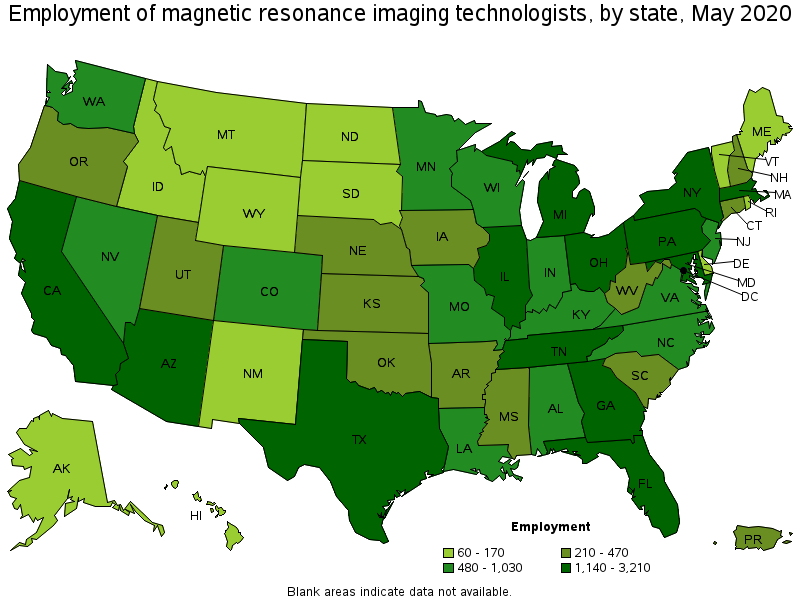
States with the highest employment level in Magnetic Resonance Imaging Technologists:
| State | Employment (1) | Employment per thousand jobs | Location quotient (9) | Hourly mean wage | Annual mean wage (2) |
|---|---|---|---|---|---|
| Florida | 3,210 | 0.38 | 1.35 | $ 32.16 | $ 66,900 |
| California | 2,870 | 0.17 | 0.62 | $ 50.98 | $ 106,040 |
| Texas | 2,530 | 0.21 | 0.74 | $ 35.78 | $ 74,430 |
| Illinois | 2,340 | 0.42 | 1.47 | $ 35.50 | $ 73,850 |
| New York | 2,140 | 0.25 | 0.87 | $ 42.69 | $ 88,800 |
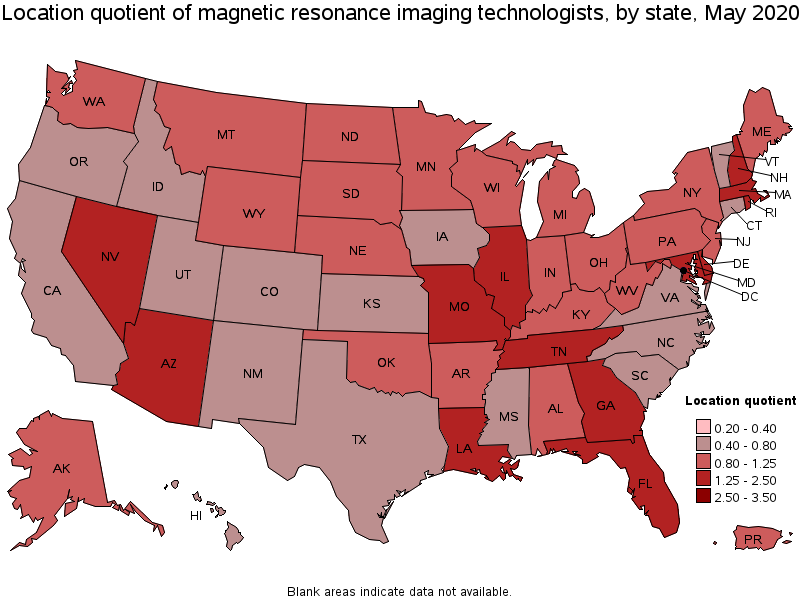
States with the highest concentration of jobs and location quotients in Magnetic Resonance Imaging Technologists:
| State | Employment (1) | Employment per thousand jobs | Location quotient (9) | Hourly mean wage | Annual mean wage (2) |
|---|---|---|---|---|---|
| Nevada | 650 | 0.52 | 1.85 | $ 43.20 | $ 89,860 |
| New Hampshire | 300 | 0.48 | 1.70 | $ 37.04 | $ 77,040 |
| Maryland | 1,140 | 0.45 | 1.60 | $ 37.80 | $ 78,610 |
| Louisiana | 800 | 0.45 | 1.58 | $ 29.79 | $ 61,970 |
| Tennessee | 1,290 | 0.44 | 1.58 | $ 29.38 | $ 61,110 |
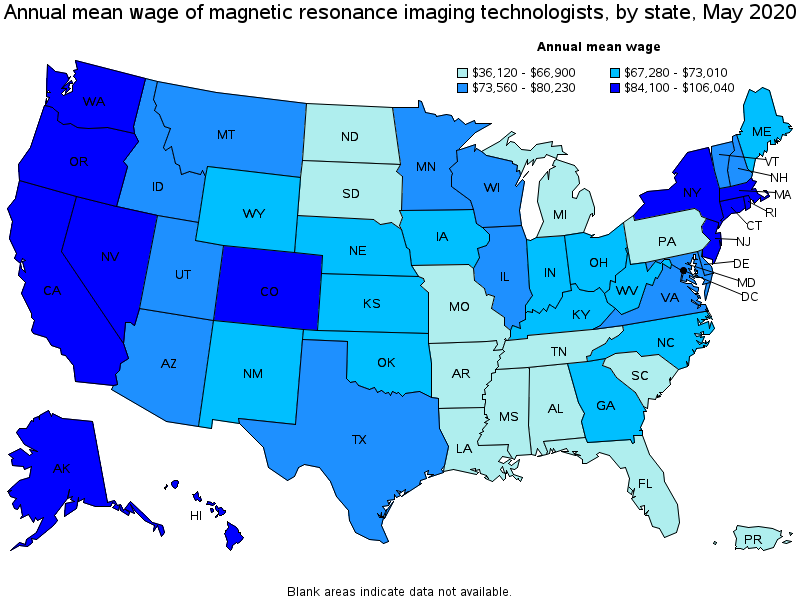
Top paying states for Magnetic Resonance Imaging Technologists:
| State | Employment (1) | Employment per thousand jobs | Location quotient (9) | Hourly mean wage | Annual mean wage (2) |
|---|---|---|---|---|---|
| California | 2,870 | 0.17 | 0.62 | $ 50.98 | $ 106,040 |
| District of Columbia | 80 | 0.12 | 0.41 | $ 46.20 | $ 96,100 |
| Hawaii | 100 | 0.18 | 0.62 | $ 46.15 | $ 96,000 |
| Washington | 800 | 0.25 | 0.89 | $ 46.08 | $ 95,850 |
| Alaska | 70 | 0.25 | 0.88 | $ 43.92 | $ 91,360 |
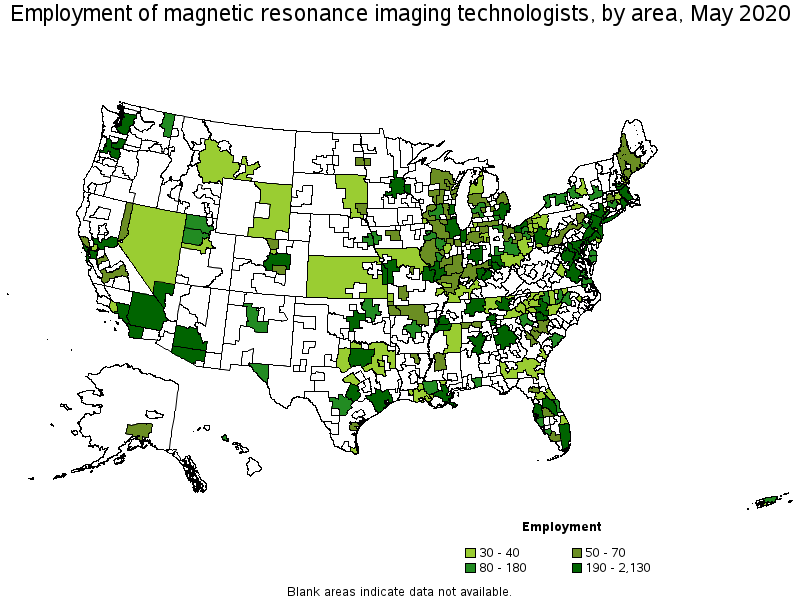
Metropolitan areas with the highest employment level in Magnetic Resonance Imaging Technologists:
| Metropolitan area | Employment (1) | Employment per thousand jobs | Location quotient (9) | Hourly mean wage | Annual mean wage (2) |
|---|---|---|---|---|---|
| New York-Newark-Jersey City, NY-NJ-PA | 2,130 | 0.24 | 0.86 | $ 44.37 | $ 92,290 |
| Chicago-Naperville-Elgin, IL-IN-WI | 1,620 | 0.37 | 1.32 | $ 36.34 | $ 75,580 |
| Atlanta-Sandy Springs-Roswell, GA | 1,190 | 0.45 | 1.60 | $ 35.40 | $ 73,640 |
| Boston-Cambridge-Nashua, MA-NH | 1,190 | 0.46 | 1.61 | $ 41.17 | $ 85,630 |
| Los Angeles-Long Beach-Anaheim, CA | 1,140 | 0.20 | 0.70 | $ 50.27 | $ 104,560 |
| Philadelphia-Camden-Wilmington, PA-NJ-DE-MD | 940 | 0.35 | 1.24 | $ 33.97 | $ 70,650 |
| Dallas-Fort Worth-Arlington, TX | 940 | 0.26 | 0.93 | $ 36.44 | $ 75,780 |
| Phoenix-Mesa-Scottsdale, AZ | 850 | 0.40 | 1.43 | $ 37.49 | $ 77,980 |
| Miami-Fort Lauderdale-West Palm Beach, FL | 760 | 0.30 | 1.08 | $ 32.83 | $ 68,280 |
| Washington-Arlington-Alexandria, DC-VA-MD-WV | 760 | 0.25 | 0.89 | $ 39.85 | $ 82,900 |
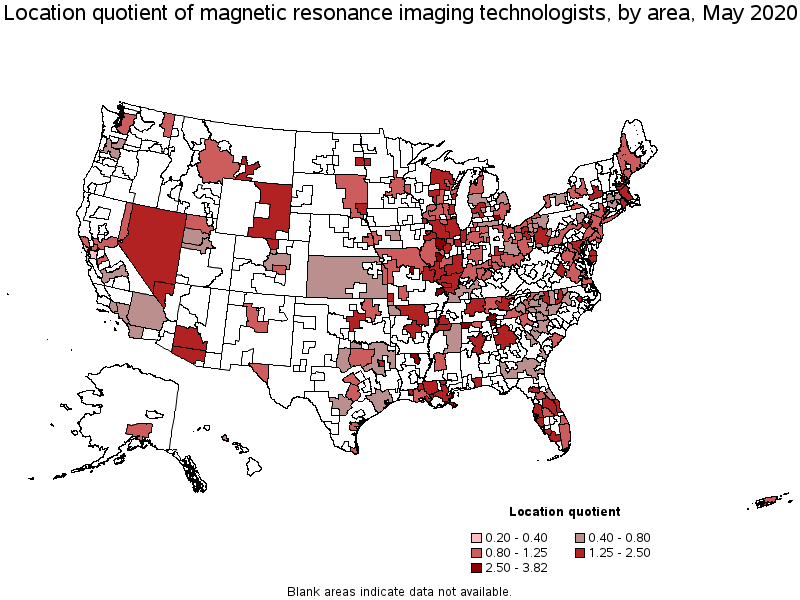
Metropolitan areas with the highest concentration of jobs and location quotients in Magnetic Resonance Imaging Technologists:
| Metropolitan area | Employment (1) | Employment per thousand jobs | Location quotient (9) | Hourly mean wage | Annual mean wage (2) |
|---|---|---|---|---|---|
| Florence-Muscle Shoals, AL | 60 | 1.08 | 3.82 | $ 25.90 | $ 53,860 |
| Manchester, NH | 100 | 0.96 | 3.41 | $ 39.09 | $ 81,300 |
| Peoria, IL | 140 | 0.88 | 3.13 | $ 32.31 | $ 67,210 |
| Chattanooga, TN-GA | 200 | 0.84 | 2.99 | $ 28.24 | $ 58,750 |
| Springfield, IL | 80 | 0.80 | 2.84 | $ 34.45 | $ 71,650 |
| Dover-Durham, NH-ME | 40 | 0.75 | 2.65 | $ 35.19 | $ 73,200 |
| Columbia, MO | 70 | 0.75 | 2.65 | $ 30.86 | $ 64,190 |
| Cape Girardeau, MO-IL | 30 | 0.74 | 2.62 | $ 28.98 | $ 60,270 |
| Monroe, LA | 50 | 0.73 | 2.60 | $ 29.96 | $ 62,310 |
| Ann Arbor, MI | 150 | 0.73 | 2.57 | $ 33.50 | $ 69,690 |
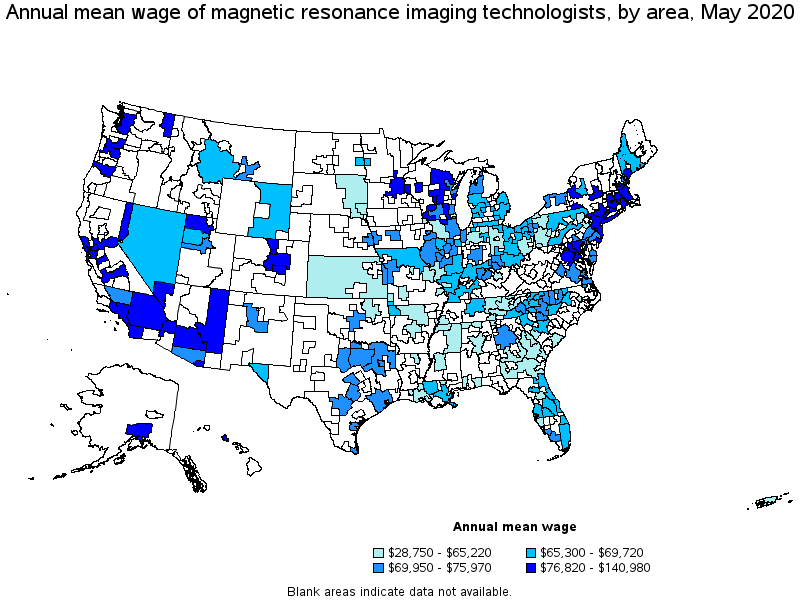
Top paying metropolitan areas for Magnetic Resonance Imaging Technologists:
| Metropolitan area | Employment (1) | Employment per thousand jobs | Location quotient (9) | Hourly mean wage | Annual mean wage (2) |
|---|---|---|---|---|---|
| Vallejo-Fairfield, CA | 30 | 0.23 | 0.81 | $ 67.78 | $ 140,980 |
| San Francisco-Oakland-Hayward, CA | 260 | 0.11 | 0.39 | $ 60.86 | $ 126,590 |
| Modesto, CA | 50 | 0.30 | 1.07 | $ 53.88 | $ 112,080 |
| Sacramento--Roseville--Arden-Arcade, CA | 260 | 0.26 | 0.94 | $ 52.81 | $ 109,840 |
| Los Angeles-Long Beach-Anaheim, CA | 1,140 | 0.20 | 0.70 | $ 50.27 | $ 104,560 |
| San Diego-Carlsbad, CA | 260 | 0.19 | 0.66 | $ 49.34 | $ 102,620 |
| Seattle-Tacoma-Bellevue, WA | 440 | 0.23 | 0.80 | $ 48.99 | $ 101,890 |
| Oxnard-Thousand Oaks-Ventura, CA | 30 | 0.11 | 0.41 | $ 48.73 | $ 101,370 |
| Fresno, CA | 60 | 0.16 | 0.58 | $ 48.11 | $ 100,080 |
| Riverside-San Bernardino-Ontario, CA | 250 | 0.17 | 0.59 | $ 47.64 | $ 99,100 |
Nonmetropolitan areas with the highest employment in Magnetic Resonance Imaging Technologists:
| Nonmetropolitan area | Employment (1) | Employment per thousand jobs | Location quotient (9) | Hourly mean wage | Annual mean wage (2) |
|---|---|---|---|---|---|
| North Northeastern Ohio nonmetropolitan area (noncontiguous) | 70 | 0.23 | 0.82 | $ 31.81 | $ 66,160 |
| Northeastern Wisconsin nonmetropolitan area | 70 | 0.37 | 1.31 | $ 37.44 | $ 77,870 |
| Northwest Illinois nonmetropolitan area | 60 | 0.49 | 1.72 | $ 28.84 | $ 59,980 |
| Southern Indiana nonmetropolitan area | 60 | 0.33 | 1.18 | $ 31.40 | $ 65,300 |
| South Illinois nonmetropolitan area | 60 | 0.70 | 2.48 | $ 33.08 | $ 68,800 |
Nonmetropolitan areas with the highest concentration of jobs and location quotients in Magnetic Resonance Imaging Technologists:
| Nonmetropolitan area | Employment (1) | Employment per thousand jobs | Location quotient (9) | Hourly mean wage | Annual mean wage (2) |
|---|---|---|---|---|---|
| South Illinois nonmetropolitan area | 60 | 0.70 | 2.48 | $ 33.08 | $ 68,800 |
| Northwest Illinois nonmetropolitan area | 60 | 0.49 | 1.72 | $ 28.84 | $ 59,980 |
| East Central Illinois nonmetropolitan area | 50 | 0.46 | 1.64 | $ 32.54 | $ 67,680 |
| Southwest Louisiana nonmetropolitan area | 30 | 0.46 | 1.63 | $ 29.32 | $ 60,980 |
| North Arkansas nonmetropolitan area | 50 | 0.41 | 1.45 | $ 26.79 | $ 55,730 |
Top paying nonmetropolitan areas for Magnetic Resonance Imaging Technologists:
| Nonmetropolitan area | Employment (1) | Employment per thousand jobs | Location quotient (9) | Hourly mean wage | Annual mean wage (2) |
|---|---|---|---|---|---|
| Arizona nonmetropolitan area | (8) | (8) | (8) | $ 38.57 | $ 80,220 |
| Northeastern Wisconsin nonmetropolitan area | 70 | 0.37 | 1.31 | $ 37.44 | $ 77,870 |
| South Central Wisconsin nonmetropolitan area | 50 | 0.25 | 0.90 | $ 37.15 | $ 77,270 |
| North Texas Region of Texas nonmetropolitan area | 30 | 0.11 | 0.40 | $ 34.29 | $ 71,320 |
| West Central Illinois nonmetropolitan area | 60 | 0.35 | 1.24 | $ 34.05 | $ 70,830 |
These estimates are calculated with data collected from employers in all industry sectors, all metropolitan and nonmetropolitan areas, and all states and the District of Columbia. The top employment and wage figures are provided above. The complete list is available in the downloadable XLS files.
The percentile wage estimate is the value of a wage below which a certain percent of workers fall. The median wage is the 50th percentile wage estimate—50 percent of workers earn less than the median and 50 percent of workers earn more than the median. More about percentile wages.
(1) Estimates for detailed occupations do not sum to the totals because the totals include occupations not shown separately. Estimates do not include self-employed workers.
(2) Annual wages have been calculated by multiplying the hourly mean wage by a "year-round, full-time" hours figure of 2,080 hours; for those occupations where there is not an hourly wage published, the annual wage has been directly calculated from the reported survey data.
(3) The relative standard error (RSE) is a measure of the reliability of a survey statistic. The smaller the relative standard error, the more precise the estimate.
(8) Estimate not released.
(9) The location quotient is the ratio of the area concentration of occupational employment to the national average concentration. A location quotient greater than one indicates the occupation has a higher share of employment than average, and a location quotient less than one indicates the occupation is less prevalent in the area than average.
Other OEWS estimates and related information:
May 2020 National Occupational Employment and Wage Estimates
May 2020 State Occupational Employment and Wage Estimates
May 2020 Metropolitan and Nonmetropolitan Area Occupational Employment and Wage Estimates
May 2020 National Industry-Specific Occupational Employment and Wage Estimates
Last Modified Date: March 31, 2021